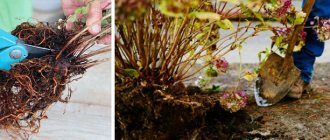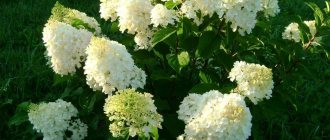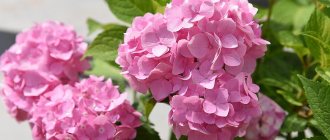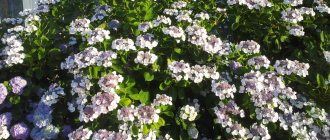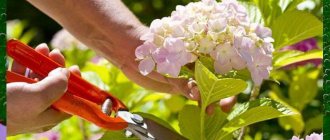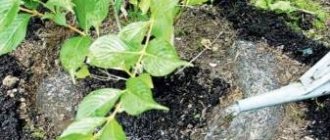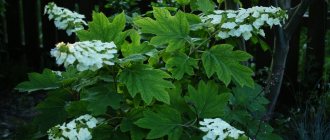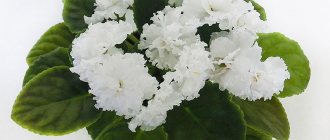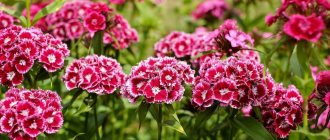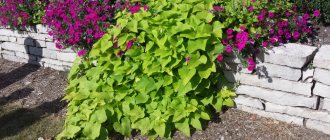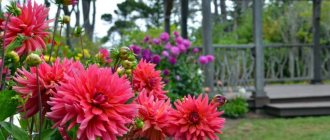Hydrangea Invisible: planting features and care tips
Foolishly, I thought that planting tree hydrangea seedlings was carried out by transshipment into open ground.
That’s what I did in the fall, and this became the reason for the death of my beauty. When I dug it up in the spring and examined the dried remains, I was horrified. The woven ball of roots, generously seeded with fertilizer, simply could not cope with rooting and died!
I sat down to study the experience of gardeners and collected a whole selection of tips that I share.
Lush pink caps above green foliage resemble floating clouds.
Some features of pink tree hydrangeas
The first pink-flowered tree hydrangea originated as a pink version of the most popular ancient white hydrangea variety, 'Annabelle'. The cultivar was bred at the Horticulture Research Station of North Carolina State University (USA) relatively recently, in 2011. To create the variety, no modern tricks were required, such as genetic engineering or irradiating seeds with radiation. According to the creators, pink hydrangea appeared as a result of a mutation after open pollination of one of the seedlings of the unnamed white hydrangea tree.
Unlike the situation with large-leaved hydrangea, soil acidity does not affect the color of the flowers of this plant, which remain pink in both acidic and alkaline soils, and do not turn blue when acidified. The foliage of tree hydrangeas with pink flowers is slightly smaller in size and more intensely colored than that of their “white” relatives. The leaves have sharper small serrations along the edges, the stems are usually thinner, and the height and shape of the bush are approximately the same.
Hydrangea with pink flowers prefers light in the morning sun and shading in the midday heat. The plant needs moist, well-drained soil. But if overwatered, the inflorescences can grow too large for the stems to support their weight, and the caps often droop.
Tree hydrangea can adapt to a variety of soil conditions, but does not tolerate drought or constant stagnation of water at the roots. Hydrangea with pink flowers is highly winter-hardy in the middle zone. But in too harsh winters, the stems may die to the ground. However, flowering occurs on the current year's shoots, which grow very quickly. Plants can even be completely pruned in the fall or late winter to encourage vigorous stem growth and improve bush shape. If not completely pruned, weakened and/or damaged stems should be removed in early spring.
Tree hydrangeas, which bloom with pink flowers, can suffer from various diseases - bacterial wilt, leaf spot, mold, rust and powdery mildew. But with good care, diseases are rarely observed.
Above is the large-flowered hydrangea (Hydrangea macrophylla), below is the tree hydrangea (Hydrangea arborescens). © Lyudmila Svetlitskaya
Plant in spring or fall
- Landing. Hydrangea should be planted in a spacious planting hole with fertile soil. To do this, you need to dig a hole measuring 50x50 cm, fill it with sand, peat and garden soil in equal proportions. Plant a seedling and cover it with soil. The root collar can be deepened by 2-3 cm.
- Care. After planting, the seedling must be watered abundantly. To retain moisture, mulch the soil around the bush with sawdust or leaves. In dry weather, the plant must be watered at least 2 times a week, 4-5 liters for each bush.
Reproduction
Hydrangea "Early sensation" propagates, like other varieties of this flower, either by layering or green cuttings. The second method is considered the most popular. In this case, the procedure must be started approximately at the moment when buds appear on the bush. A green cutting means a leafy fragment of a stem on which there are either one or several buds. It is best to take cuttings from young plants, and subject old bushes to anti-aging pruning before “use”.
As a rule, they form good kidneys and have no symptoms of disease. The cuttings are cut early in the morning and immediately placed in water in the shade. The planting material should lack a top with a bud, but have two half-shortened leaves. Experts recommend that before planting, soak the cuttings in a solution that stimulates root growth.
If you can’t buy one in the store, you can simply take a teaspoon of honey and stir it in a glass of clean water. The cuttings are planted in an irrigated mixture of peat and sand, taken in a 2:1 ratio. Ideally, a greenhouse is immediately created above the container from glass jars or cling film.
Reproduction by layering is carried out in early spring, even before the buds of the hydrangea emerge. First of all, the ground next to the bush is dug up and thoroughly leveled. Radial furrows are created so that their depth varies from 1.5 to 2 centimeters, after which one shoot is placed in them from the bottom of the bush. Additionally, the branches are fixed with special brackets and sprinkled with a little earth.
The shoot will grow, the constriction will be pressed in, and roots will appear. By the end of August, several young shoots usually form on each branch. As soon as their height reaches 15–20 centimeters, regular weekly hilling begins. It continues until the height of the mound reaches 20–25 centimeters. In October, the cuttings are dug up and separated from each other. In the spring, the resulting seedlings can be planted in the garden.
Origin and external features of Invisible hydrangea
Hydrangea has 80 subspecies, which were not popular among gardeners. The species was considered burdensome to care for, not resistant to frost, and the varieties differed little in color. Hydrangea Anabelle appeared in 2010 in North Carolina. The flower became a sensation because of its unpretentiousness and brightness. The creator bred it from the Annabelle variety.
Blooming Hydrangea Invisible
One of the main characteristics is frost resistance. The bushes can easily withstand temperatures down to -35 C. Even if the shoots are completely frozen and only the root remains, the plant will survive and bloom. Sometimes hydrangeas that have experienced stress from low temperatures bloom more profusely. It is important to ensure that the root is not damaged.
- bush height 80 cm - 1.5 m;
- in diameter it reaches 2.8 m;
- its shape is spherical;
- shape, width of the inflorescence – round, 20 cm;
- shoots are strong and can withstand the weight of flowers;
- flowers are pink (dark or bright), reaching 2 cm in diameter;
- leaves are large, elongated, dark green, with jagged edges.
Types of hydrangeas
The plant is valued not only for its ease of care. Hydrangeas are a real decoration for the garden plot and home greenhouse. There are many species, and they all differ in size, shape and color of inflorescences, as well as requirements for growing conditions.
The differences between tree and paniculate hydrangeas are clearly expressed during the flowering period
Currently, dozens of types of hydrangea are known:
- paniculata;
- tree-like;
- garden (large-leaved);
- oakleaf;
- petiolate;
- variegated;
- radiant;
- ashy;
- serrated.
To choose which species to plant on your site, you should familiarize yourself with the characteristics of each.
Hydrangea paniculata
In conditions close to their natural growing environment, the shrub reaches up to 10 m in height. Most often in Russia it is a bush with several trunks up to 2 m high. Due to the fact that the trunks have the ability to quickly lignify, this species tolerates the harsh Russian winters well.
A plant with elongated leaves, which can be either velvety or glossy depending on the variety, and pyramid-shaped inflorescences with a sharp top. The inflorescences are located on the tops of young shoots.
Important! Hydrangea paniculata has white or pale beige flowers that gradually change color, becoming bright. The most popular varieties: Phantom, Pinky Winky, Diamond Rouge, Vanilla Fraze, Grandiflora
The most popular varieties: Phantom, Pinky Winky, Diamond Rouge, Vanilla Fraze, Grandiflora.
Inflorescences of paniculate hydrangeas have the shape of a cone
Hydrangea
Tree hydrangea in the middle zone is a shrub 1.5 m high. It is rare to find taller specimens (more than 3 m). A deciduous shrub, native to North America, winters well in regions with harsh winters.
The leaves are elliptical in shape with serrated edges and have a rich green color. The back of the leaves may have a bluish tint. Smooth large leaves reach a length of up to 10 cm.
The inflorescences are spherical or flat, the color of the flowers is pink, white, purple. Formed on annual shoots.
Important! With proper care, which includes watering, fertilizing, and covering for the winter, the bush is completely covered with flowers during the flowering period. Popular varieties: Pink Piction, Invisible Spirit, White Anna
Popular varieties: Pink Piction, Invisible Spirit, White Anna.
The tree-like subspecies has spherical or flat inflorescences
Large-leaved hydrangea (garden)
In Russian gardens, the guest from Japan is quite compact in size. In its natural habitat it reaches a height of 3 m. In Russian winter conditions, such growth is impossible to achieve. Most often, large-leaved shrubs do not exceed a height of 0.5-1 m.
The plant is very decorative: the leaves are green, oblong with a pointed tip, and by the end of the season they acquire a red tint. Flowers are collected in large spherical inflorescences. The color of the petals depends on the acidity of the soil, and varies from white to blue and purple shades.
Popular varieties: Mini Penny, Expression, Red Sensation.
How the Invisible hydrangea blooms
The variety blooms from the first days of summer to mid-autumn. Often the flowers remain until the first frost of November.
Important! The color of the plant changes during the flowering period. Dark, faded, richly bright shades replace each other.
The size of the inflorescences can be controlled by proper pruning. If they have enough space in the bush, each will reach 30 cm in width.
Hydrangea Invisible is known for its variety of shades
The best varieties of hydrangea for the Moscow region: photos with names and descriptions
Low-growing paniculata
The panicle hydrangea species (Hydrangea paniculata) includes 3 best varieties that can be cultivated in the Moscow region:
- Bobo (n.b. Bobo). Refers to dwarf forms. The flowering period lasts a long time and is quite abundant. The color of the flower petals changes from white to pink. The small height of the bush allows you to grow this variety in containers.
- Vanilla Fraise (N. r. Vanille Fraise). Suitable for growing in open areas, since during the growing season the height of the bush reaches 2 m. The diameter of the inflorescences ranges from 25-30 cm. The color of the petals can vary from lilac to crimson. Its popularity is due to the fact that flowers on one bush can have several shades at the same time.
- Wims Red (N.r. Wim's Red). The inflorescences have a lush cone shape, up to 35 cm long. The bush attracts insects, which is due to the pleasant honey aroma that the flowers emit. The flowering period lasts from early summer until the first frost. The color of the petals gradually changes from white to pink, and then becomes bright red.
The best varieties of paniculate hydrangea in the photo with names:
The varieties do not require careful care and take root well in the Moscow region.
Tree hydrangea
The type of tree hydrangea (Hydrangea arborescens) is the most common among gardeners in the Moscow region. The best varieties of tree hydrangea for the Moscow region:
- Annabelle (N. a. Annabelle). It has a high level of resistance to frost, which allows this variety to be grown in the Moscow region. The height of the bush can reach 150 cm, and the diameter of the bush varies between 3-3.5 m. The decorative effect of the plant remains until the first frost. The flowering period lasts from mid-summer and continues until the end of September. The diameter of the inflorescences can be up to 25-30 cm.
- Grandiflora (N. a. Grandiflorum). The height of the bush is 2 m, and its diameter ranges from 2 to 3 m. The crown has the shape of a ball. The length of the dark green leaves reaches 16 cm. The inflorescence is white with a fodder tint. The variety requires a lot of light and moisture and does not tolerate drought. The shrub is often used as a hedge.
- White House (N. a. White Dome). The height of the plant varies between 1-1.5 m. The crown has a dome-shaped shape. The shrub is valued for its beautiful elastic and strong white-cream inflorescences. Inflorescences are formed on young pagons. The flowering period lasts until early October. The variety tolerates both direct sunlight and partial shade.
The popularity of tree hydrangea varieties is due not only to their attractiveness, but also to their adaptability to the climatic conditions of the Moscow region.
large-leaved
This species is also known as macrophylla or garden hydrangea (Hydrangea macrophylla). The best varieties of large-leaved hydrangea for the Moscow region:
- Endless Summer (N. m. Endless Summer). This variety can withstand frost down to 30°. The middle part of the inflorescence is occupied by purple flowers, and along its edge there are white-green flowers.
- Blooming star (N. m. Bloom Star). The diameter of the inflorescence can be up to 19 cm. If the shrub is grown on alkaline soils, the color of the inflorescences becomes blue-violet. In other cases, the inflorescences have a bright burgundy hue.
- Mirai (N. m. Mirai). The flowers are distinguished by a beautiful white-pink color, which gradually changes to light green.
This species became the ancestor for the development of a large number of varieties adapted for cultivation in the Moscow region.
Chereshkova
Petiolate or climbing hydrangea (Hydrangea petiolaris) has a high level of resistance not only to severe frosts, but also to diseases. The best varieties of petiole hydrangea for the Moscow region:
- Miranda (N. r. Miranda). The leaves of this variety have a beautiful green color with a glossy surface. The flowers are small. Their size does not exceed 12 cm in diameter. The shrub has the appearance of a vine, the height of which reaches 10 m. It grows in shaded places. Does not tolerate shade well.
- Cordifolia (N. r. Cordifolia). The shrub grows to a height of no more than 1.5 m. It is resistant to diseases, insect damage, and severe frosts (up to 30°). The edges of the green leaves are jagged. The flowers have a cream color. The flowering period begins in early summer and lasts about 30 days.
The properties of varieties of this species make it possible to cultivate them in the Moscow region.
Transplanting Invisible Spirit hydrangea after purchase into open ground
It is important that the flower adapts and takes root correctly. To do this, take into account recommendations for choosing a place and landing time.
What is needed for planting
You need to choose the right cuttings, seedlings or seeds. A good cutting has a couple of leaves, a seedling has 3 or more buds. The seeds of this variety are bright brown, elongated, small. High-quality seed does not have dirty spots or damage.
Selecting a location
In sunny regions, the crop is planted under openwork partial shade. The tree-like plant tolerates heat calmly. In a bright place, the soil at the root is moistened several times more often. In the northern regions, the flower takes root better in sunny places, under direct rays. The area is cleared of weeds, the ground is loosened, slightly leveled, and nutrients (fertilizer) are introduced.
Boarding time
Determined by the climate of the region. Spring and autumn are suitable for southern Russia. Flower growers in other regions plant the crop only in the spring so that it has time to adapt.
Step by step planting process
Planting a seedling includes the following steps:
- Check the root system. There are no damaged or dried elements on the roots of a high-quality seedling. They are the same size, not bunched together.
- Make a hole that will accommodate the rhizome. Add a little humus with sand.
- Place the seedling so that the neck is in line with the ground. The roots adapt better if they are first left for 2 hours in heteroauxin.
- Cover the root with soil and water it abundantly. As the soil settles, more soil is added.
- Maintain soil moisture so that rooting and development proceed normally. The optimal water temperature is 25 degrees. Watering schedule: 2 times a week.
Important! Flowering occurs only 4 years after planting the flower.
Landing
Hydrangea is a rather finicky plant, so you need to choose a planting site carefully. Moreover, the plant is perennial and should not be replanted often. Hydrangea loves shaded areas, but it is necessary to create such conditions that there is enough light. Its deficiency leads to poor flowering and at the same time its abundance causes the need for additional watering. From direct rays of the sun on a hot afternoon, the inflorescences simply burn out.
Important! Soil rich in clay or humus is preferable, but in red soil the plant will quickly die. Sandy soils are generally not permissible. Also, the plant will not tolerate too moisture-loving neighbors, since it is quite demanding on the level of soil moisture
It is also necessary to ensure that the planting site remains mostly windless. The variety in question prefers rich soils without excess lime. When planting, you need to add humus, peat, and sand into the clay medium. The tree trunk circle must be mulched with peat or fallen pine needles. From an excess of salts in the soil, the bushes begin to turn yellow or even get sick.
Also, the plant will not tolerate too moisture-loving neighbors, since it is quite demanding on the level of soil moisture. It is also necessary to ensure that the planting site remains mostly windless. The variety in question prefers rich soils without excess lime. When planting, you need to add humus, peat, and sand into the clay medium. The tree trunk circle must be mulched with peat or fallen pine needles. From an excess of salts in the soil, the bushes begin to turn yellow or even get sick.
Soil acidity:
- alkaline - unacceptable, since the bush’s development slows down and rapid death occurs;
- neutral is acceptable, but the bloom of the Invisible Spirit hydrangea will be extremely dull, inexpressive and faded;
- in acidic soil the brightest specimens are obtained.
Previously, there was even an extraordinary way to fertilize the soil for brighter flowering: various iron objects (nails, horseshoes, etc.) were buried under each plant. Nowadays, gardeners with experience recommend simpler ways to acidify the soil, fortunately, stores offer an assortment of products for this purpose.
Landing dates
It is best to plant the Invincibelle Spirit variety in the ground in early spring, before the buds open. If the seedlings have a well-developed root system, they can be planted in early autumn. Theoretically, it can be planted in the summer, but since the plant is extremely moisture-loving, and this time of year can be hot and dry, spring is still preferable. However, if in summer there is the possibility of daily abundant watering, this is acceptable. If the landing is planned in a place that you rarely visit, then it is better not to take risks with the landing time.
Preparing the soil and seedlings
First you need to prepare the planting hole. The hole being dug is quite large. This is especially true if planting is done on not too rich soils, since you need to think about filling the hole with nutrients (a small amount of sand and humus). Also, naturally, the rhizome itself should fit.
Find out what soil is needed for planting garden hydrangea.
The seedling must have a developed root system with a small lump of earth. Immediately before planting, the roots are carefully inspected, dry and damaged parts are removed.
The roots are trimmed to be approximately the same length and carefully untangled
Planting process
Since the plant in question resembles a tree more than a flower, it is planted accordingly. But this process has no fundamental features.
Step-by-step instructions for planting hydrangeas:
- Build a landing pad in the form of a mound in the center of the hole.
- Lower the plant onto the planting area and spread out the roots well.
- Fill the hole, being careful not to create a void.
- After planting, water thoroughly. If necessary, add a little soil, as it may settle.
- Immediately near the trunk, mulch the surface with peat - this will protect the hydrangea from overheating, as well as from drying out the soil.
Propagation of hydrangea Invisible Spirit
Tree hydrangea Invincibelle is propagated by 4 methods:
Propagation by cuttings
In July, annual cuttings are cut off. In order to take root better, they are covered with rootstock. Such a shoot is inserted into a mixture of coarse sand and acidic peat in a 1:2 ratio. Sphagnum moss is also added to the mixture.
The cuttings are immersed in the soil, leaving 5 cm between them. They are rooted 3 cm, at a slight slope.
Growing from cuttings
Choose a strong shoot and bend it to a small depression in the ground. Cover with earth and secure with wire. A well-fixed layer will not straighten and take root.
Soil is poured into the hole 4 times during the summer season. After a year, the roots will get stronger, you can cut off the seedling with pruners. The cuttings should grow in the shade. After a couple of years it can be planted in permanent soil.
Reproduction methods
If a bush has thanked you for your painstaking care with sweeping, rich blooms, it’s hard to resist enhancing its beauty. The plant can be propagated by seeds, cuttings, layering, or by instilling seedlings. Densely branched specimens can be planted by dividing the bush. But the first three methods remain the most popular, each of which has its own advantages, disadvantages and agrotechnical features. By doing them correctly, you will have new irresistible hydrangeas in your garden.
Seeds
The process of planting seeds itself does not take much time, but the result obtained can be expected for years, so this method is rarely practiced in garden plots in favor of other methods.
Plant propagation by seeds is usually used by breeders, but if you decide to try your luck, then you must adhere to the following steps:
- In February, prepare the seeds and soak them in potassium permanganate or copper sulfate solution for 2–3 hours.
- Place the seed on damp gauze and wait until it swells.
- Fill the germination container with a soil mixture of soil, peat and sand.
- Place the seeds on top without deepening them.
- Sprinkle with a layer of sand.
- Cover the container with glass or film.
- Periodically moisten the soil with a spray bottle.
- When the second leaves appear, plant the plants in pots.
- Two years after germination, plant in open ground according to the technology described above.
When choosing a seed method, it is better to choose large-leaf Hydrangea varieties. A plant grown from seeds needs more feeding.
Did you know? The greatest germination is achieved by seeds brought from the natural habitats of hydrangea - Japan and China.
Cuttings
If you want to get a young seedling next year, you can resort to cuttings. To do this, before mid-summer, you need to cut the required number of cuttings from the center of the bush. It is better to choose young shoots with two pairs of leaves and pinch them off 1 cm below the buds. To stimulate growth, treat the ends of plants cut at an angle with “Phytoklon”, “Kendal”, “Kornevin”, “Mega Vega”.
Plant the cuttings in pots with a mixture of peat, sand and humus, deepening to the level of two buds. Then water and wrap the pot with polyethylene. Place the containers in a sunny place to rot. Also, do not forget to control soil moisture and periodically add water. Young shoots should be planted in open ground in the spring, after wintering at home.
By layering
Many gardeners prefer this method for its ease and speed. For propagation, a young shoot no older than one year is selected. If you want to get many layers, you can choose 3-4 branches.
The procedure is recommended to be carried out in spring or early summer, following the scheme:
- Bend the branch towards the ground and draw its length.
- Dig a furrow 15 cm deep along the line.
- Place the shoot in the ditch and pin it with metal pins.
- Leave the edge of the branch open, it should “breathe”.
- Sprinkle the areas around the buds with soil or peat.
- Water along with the main bush, adding soil if necessary.
- Cover with spruce branches and leaves for the winter.
- Plant in a permanent location in the spring.
The resulting layering can be planted after three weeks using the cutting principle. In this case, for wintering they are transplanted into pots and brought into the house.
Caring for Invisible Spirit hydrangea
Hydrangea invincible spirit needs the following manifestations of care:
- feeding;
- mulching;
- watering;
- formative and sanitary pruning of bushes.
Watering mode
Invincibelle spirit hydrangea loves liquid. You need to water her once every 3 days. Watering volume – 10 l. Do not water with too cold water (below 20 degrees).
Top dressing
Feed the flower 4 times:
- during shoot growth, nitrogen fertilizer is introduced;
- when buds appear, fertilize with superphosphate and potassium sulfate;
- the remaining fertilizers continue to add substances from the previous point.
Mulching
Carry out as soon as shoot growth begins. Peat and sawdust are used, which are distributed in a layer of 5 cm.
Attention! Mulch should not get on the trunk or shoots. Under its direct influence, the plant will begin to rot.
Shrub pruning
At the beginning of spring, formative pruning is performed to promote the development of strong branches and wide paniculate inflorescences. If the bush is too thick, the circulation of nutrients is impaired. Some of the shoots are cut off, the plant is fertilized with a complex of minerals. Sanitary pruning involves the removal of damaged, diseased, dry, old shoots.
Features of care during the flowering period
During the flowering period, make sure that:
- the plant had enough moisture;
- pests did not appear on it;
- pruning was carried out correctly.
Hydrangea Invincible Spirit will be healthy if you place it in fertile soil, regularly water it, and provide access to sunlight.
Features of care during the rest period
The dormant period for tree hydrangea Invisible is late autumn, winter. At this time, the bush is trimmed, tied up, and is under film. It does not require additional care.
Preparing for winter
Prepare the crop for cold weather sequentially:
- In September, water less abundantly than in summer. The amount of water is reduced gradually. Before the November cold, watering is reduced to zero.
- At cold temperatures, the crop sheds its leaves. To help it, you need to cut off the inflorescences and tops of the stems.
- After cutting off the leaves and shoots, the bush is tied up.
- The soil around the Invisible Spirit hydrangea is sprinkled with a fresh layer of mulch.
- If the autumn season turns out to be rainy, the bush is covered with film. A wire frame covered with polyethylene is built over the hydrangea. The film must allow air to pass through from below so that the bush does not suffocate. Wrapping is mandatory for northern territories.
Hydrangea after winter
Hydrangea Invisible is a young variety, well adapted to aggressive climates and temperature changes. This is an unpretentious crop with bright lush inflorescences. The only drawback of the flower: it will have to wait for flowering.
Invisible Spirit: variety of tree hydrangea, planting and care, growing in the garden
Hydrangea is popular among professional flower growers, landscape designers and among amateurs who grow flowers in their garden plots. An unpretentious and very decorative plant can delight with lush pink blooms from the first days of summer until mid-October.
Origin and appearance of hydrangea Invisible Spirit
Hydrangea Invincibelle Spirit, like other varieties of this plant species, belongs to the genus Hydrangea. Descriptions of the largest number of wild species of this genus were made on the Japanese Islands and in China.
Hydrangea Invisible Spirit
Tree hydrangea Invincibelle is a shrub 0.9-1.5 meters in height. The bush is quite voluminous, it can grow up to 3 meters wide, so the plant requires regular pruning and formation of the bush. The leaves are oblong, with a jagged edge, quite large, rich green in color. In autumn they turn bright yellow, giving the garden greater decorative value.
Note! This flower was presented to flower growers in 2010, so it can be considered very young. Invisible Spirit was bred by a breeder from the USA, whose goal was to obtain a variety that was unlike all the others.
How the Invisible Spirit hydrangea blooms
The inflorescences of the tree hydrangea Invisible Spirit consist almost entirely of sterile flowers, have an irregular spherical shape, the diameter of such a ball can reach 30 cm.
The color of the corollas varies from dark pink to bright pink. At the very beginning of flowering, the color of the corollas is dark pink, but over time it becomes bright pink.
The variety blooms for a long time - from early June to mid-October.
Bright flowering Invisible Spirit
In landscape design, both tapeworm (single plant) and in group plantings and in compositions with other plants are used. Hedges made from this plant look beautiful. Often Invincibelle Spirit hydrangea is meant when talking about another variety - Pink Annabelle.
Transplanting Invisible Spirit hydrangea after purchase into open ground
It is better to plant the bush in early spring or autumn. It is not recommended to replant the plant in the summer during flowering. The plant will drop its flowers and buds and refuse to bloom the next season.
What is needed for planting
For planting, prepare a hole measuring 50x50x50 cm. A day before transplanting, water the hole generously with water. A mound of specialized soil for hydrangeas is poured onto the bottom. Add 20 g of superphosphate and potassium sulfate to it.
Important ! The hole should be such that the root system of the seedling fits freely in it.
Choosing the optimal location
Hydrangea Invincibelle Spirit is planted in a sunny place or in partial shade. The soil is preferably fertile, well-moistened and drained, with an acidic reaction (pH 4.5-5). A hydrangea growing in the wrong place will bloom and develop poorly.
The place for planting the plant must meet the following requirements:
- Diffused lighting. Direct rays of the sun appear only in the morning.
- Quiet, protected from the winds.
- Moist soil, but without stagnant processes.
- Acidic soil reaction (pH 4.5-5).
Step by step planting process
To properly transplant hydrangea, you need to take the following steps:
- Transfer the seedling to the prepared hole.
- Gently straighten the roots.
- Fill the hole with soil.
- Water generously.
- Mulch with peat, bark, sawdust.
Important! The root collar can be buried no more than 2-3 cm.
Propagation of hydrangea Invisible Spirit
Hydrangea Pink Lady - growing in open ground, variety description
Self-propagation of hydrangeas is a fascinating process. Let's look at the most common methods.
Propagation by cuttings
Propagation by green cuttings is the easiest and most affordable option. Green stalk - part of a stem with leaves and several buds.
Planting material is prepared in mid-July. Cuttings will take root well:
- From young plants or those that have undergone anti-aging pruning.
- Chopped from side branches in the lower, well-lit part of the bush.
- No signs of diseases or pests.
- Collected early in the morning.
Hydrangea cuttings
Rooting order:
- Remove the top with the bud (if any) from the shoot.
- Divide the remaining shoot into segments with 2-3 pairs of leaves.
- Cut off the lower leaves from each cutting and shorten the upper ones by a third.
- Place the cuttings in a rooting stimulator solution for 2 hours.
- Rooting is carried out in a moistened mixture of sand and peat (1:2).
- The cuttings should be covered with a jar.
- It is necessary to water the cuttings 2-3 times a week.
- After a month, the banks are removed.
Growing from cuttings
Hydrangea is propagated by layering in early spring.
The breeding order is as follows:
- The soil around the bush is loosened and leveled.
- Radial grooves up to 4 cm deep are laid at the base of the bush.
- Several lower shoots are placed in the grooves and pinned.
- By September, 2-3 young plants are formed on each layer.
- When the children reach a size of 15-20 cm, they need to be hilled to form lateral roots.
- In October, young hydrangeas should be separated from the mother shoots and buried until spring.
Dividing the bush
Dividing a hydrangea bush is combined with replanting. The bush is carefully dug up and divided into several parts with sharp pruning shears, resulting in new small bushes. Delenki are rooted in the same way as seedlings. It is better to divide the bushes in the fall. Tree varieties tolerate this procedure well.
Caring for Invisible Spirit hydrangea
Hydrangea Bombshell paniculata - description
Tree varieties of hydrangeas are quite capricious and whimsical. This was the case before the appearance of the Invincible Spirit hydrangea variety. He has accumulated all the best features in himself, caring for him has become simpler and easier.
Watering mode
Hydrangeas love moisture; drought is dangerous for them. You need to water with slightly acidified water.
Watering is the most important agrotechnical activity
In hot weather, water twice a week. With normal rainfall, the bushes will need to be watered 5 times per season. 3-4 buckets of water are poured under one bush at a time.
Top dressing
In order for hydrangea to bloom profusely and for a long time, it is fed at least 2 times a year. The first feeding is in the spring before the buds appear, the second in the autumn after flowering. In the spring, fertilize with a urea solution (10 tsp per bucket of water). Each bush will need 3 buckets of solution. In autumn, complex fertilizer is applied.
Note! There are many complex fertilizers for hydrangeas on the market. Using them will provide plants with all the necessary nutrients.
Trimming
The variety tolerates pruning well in early spring. Between March and April, all dead and damaged branches are removed. Healthy shoots are shortened by a third of their length, leaving at least three buds on each.
By pruning hydrangea, we prepare it for summer flowering.
When pruning, you need to remember that the inflorescences of tree hydrangea, unlike paniculata, appear on the shoots of the previous year.
Features of care during the flowering period
During flowering, the plant needs regular, abundant watering. At the very beginning of the opening of the buds, you can feed the bushes with a solution of mullein or chicken droppings (1:10).
Features of care during the rest period
After the plant has flowered, it is prepared for wintering:
- Remove faded inflorescences.
- Hill up the base of the bush.
- Mulch the ground.
- Cover with spunbond on the arches.
Preparing for winter
Even if the winter is predicted to be mild, it is better to play it safe and cover the bushes. This is usually done in October. The branches are tied, pressed to the ground, and spunbond or lutrasil are used as cover.
Flower growers who have been growing the variety for several years note an interesting feature: after a harsh winter, hydrangea blooms brighter and more abundantly than usual. Even complete freezing of the aboveground part does not prevent it from recovering and blooming again in June.
Tree hydrangea Invisible Spirit combines many positive characteristics of members of its family:
- unpretentiousness;
- frost resistance, good adaptation to temperature changes;
- unique color of inflorescences.
Hydrangea Invisible Spirit is the most suitable variety for the climatic conditions of central and northern Russia. That is why it is so popular and is actively used in landscape design.
Source: https://greensotka.ru/tsvetushchie/gortenziya-invizibl.html
Brief description of culture
- Shape: deciduous bush with a round spreading crown.
- Size: bush 90-150 cm tall, up to 280 cm in diameter.
- Flowering period: June - early October.
- Flower color: from dark pink to bright pink.
- Inflorescences: irregular spherical shape, 20-30 cm in diameter.
- Leaves: large, oblong, green (with a yellowish tint in autumn) with serrated edges.
Tree varieties of hydrangea were not popular among amateurs and experienced gardeners. They were fastidious to care for, not too resistant to cold, and also did not differ much in color from the mother form (all inflorescences of the subspecies are white). This was the case until the appearance of a new variety - Invincible Spirit. Hydrangea has absorbed the best qualities, and most importantly, acquired an unusual color of inflorescences.
Hydrangea Invincible Spirit (flower appearance)
Nurseries often use the term Pink Annabelle when selling this species, which is incorrect. After selection, hydrangea was patented as invincibelle spirit, which translated from English means “invincible spirit.”
Interesting! A new flower was developed from the Annabelle variety in 2010. The author is breeder T. Early from North Carolina, working at the research center of a local university.
Hydrangea Bouquet Rose large-leaved: appearance and history of origin
Large-leaved hydrangea spread across Europe from France, where it in turn was brought more than two centuries ago from China. An unknown shrub with balls of delicate flowers of various shades was named after the sister of the French Prince of Nassau-Siegen, the beautiful Hortense.
Hydrangea Bouquet Rose comes in various shades
One of the most picturesque varieties of large-leaved hydrangea is the Bouquet Rose hydrangea. The plant is a deciduous shrub, shaped like a ball, with a height and width of about 1-1.3 m (if the plant is grown in containers, the dimensions are significantly reduced, amounting to approximately 0.5-0.6 m). The leaves of hydrangea are large, opposite, oblong, ovoid in shape. The upper surface of the leaf is rich green in color, slightly rough, the lower surface is more velvety.
The color of the rather large flowers, collected in spherical inflorescences with a diameter of about 25-30 cm, varies from white to various shades, from pink to lilac and from pale blue to purple. The color depends on the acidity of the soil in which the plant grows: Bouquet Rose hydrangea (Early Rose hydrangea) acquires blue shades of color with increased acidity due to the ability to accumulate aluminum and form chemical compounds with it, and lilac and beige shades are the result of exposure to alkaline soils.
The use of alum when watering makes it possible to obtain different colors of flowers on one bush
For your information! You can get the desired color by using crystals of aluminum or iron salts (alum) when watering, which are dissolved in water for irrigation and used 2-4 times a month.
For the purpose of coloring the flowers of the plant, you can use peat, which is either added to the soil and used as mulch, or dissolved in water and the resulting solution is used for watering.
Also, some gardeners use special dyes sold in flower shops. And some of them use rusty nails, which are inserted into the soil at the roots of the plant.
Features and appearance
Hydrangea Invisible has excellent frost resistance; it can easily overwinter in a flower bed. If it suffers slightly from the cold, this will not have a bad effect on the plant; rather, on the contrary, it will create favorable conditions for the subsequent formation of an abundance of inflorescences. Even after the shoots have completely frozen, hydrangea is able to bloom. The main thing is that the root system is not damaged. This variety is assigned a high frost resistance class: USDA 3, it can withstand temperature drops down to −37°C.
The average width of the bush is about 150 cm, height 120 cm. The shoots are quite strong, occasionally bending due to the weight of the inflorescences.
Description of the variety
The variety Invisible (Invincibelle Spirit) appeared quite recently and, perhaps, not every gardener knows about its existence. It is a tree-like shrub with deciduous leaves, the shape of which resembles a delicate cherry marshmallow, as its inflorescence comes in both dark and bright pink colors. A distinctive feature of this variety is the change in the shade of the petals during flowering: at an early age they have a pink tint, which changes to a darker color over time.
Did you know? In the Japanese city of Hirata, a garden center was created where 372 species of hydrangeas were planted. It was even included in the Guinness Book of Records under the name “Jupia Land Hirata”.
Thanks to selection, Invisible hydrangea has received the best qualities and invariably attracts the attention of others. It has fairly strong shoots that do not break when bent. It is frost-resistant, withstanding temperatures down to -37°C, and its condition does not deteriorate due to cold weather, but, on the contrary, improves, increasing the abundance of flowering
It is frost-resistant, withstanding temperatures down to -37°C, and its condition does not deteriorate due to cold weather, but, on the contrary, improves, increasing the abundance of flowering.
Reproduction and planting
This variety is propagated in three ways: by dividing bushes, cuttings or seeds.
Planting seedlings
To propagate by division, a woody shrub is dug up and divided into 2-3 parts. There should be at least 3 buds left on each.
For planting tree hydrangea varieties Invincibelle Spirit, loose, moderately moist soil of average fertility is suitable. Alkaline soils are not suitable; soil pH should be 4.5-7.
Hydrangea tree Invisible Spirit
Flowers should be planted in early spring in shaded areas. When landing you need to follow the instructions:
- Prepare a hole measuring about 50*50 cm (depending on the volume of the seedling's root system).
- If the soil is poor in nutrients, the hole should be expanded and filled with soil of high fertility.
- Insert the bush with formed roots into the hole and straighten them.
- The root collar should be deepened no more than 2.5-3 cm.
- Cover with fertile soil.
- Water the seedling generously.
- Mulch with a layer of peat 5-7 cm thick.
Propagation by cuttings
In mid-summer, one-year-old young side shoots are cut out. To improve rooting, treat with root. Then they are placed in a humid environment: coarse sand is mixed with acidic high peat (1:2) with the addition of sphagnum moss.
Important! The cuttings are planted at a distance of 5 cm from each other, rooting 2-3 cm at a slight slope.
Seeds
You should prepare the landing site in advance:
- clear of weeds;
- dig up;
- level with a rake;
- fertilize.
Hydrangea planting seeds
Then scatter the seeds randomly, lightly pressing them into the soil, but without burying them. Make a small mound of sand on top (this is drainage) and spray with a small amount of water.
Hydrangea tree Invincibelle Spirit
Invincibelle Spirit is a relatively new variety of tree hydrangea recently imported to our country. This is a real breakthrough in the selection of Hydrangea arborescens; the flower has won the hearts of thousands of flower growers around the world.
Description of the variety
Translated from English, “Invincible” means “invincible”, and “spirit” means “spirit”. Due to the similarity with the widespread variety Annabelle, the originators somewhat distorted the first word in the name - “Invincibelle”. Given its amazing winter hardiness, “Invincible Spirit” is a fairly accurate description of the flower.
The variety was bred in the USA, thanks to the efforts of breeder Thomas Early from North Carolina. Tree varieties of hydrangea were of interest to many amateur gardeners in our country, but the large-leaved varieties of this plant were too demanding to care for and not adapted to harsh winters. Ordinary varieties with inconspicuous white flowers, despite their unpretentiousness and good winter hardiness, did not arouse much interest among amateur gardeners.
The new variety has absorbed the advantages of the best representatives of the species. It is quite resistant to diseases and winter-hardy, while it has beautiful dark pink flowers, which over time change color to bright pink, which gives the flower a certain amount of originality. On an unpruned bush, many pink inflorescences with a diameter of up to 20 cm are formed; with the use of pruning, the size of the inflorescences can be increased to 25-30 cm. The height of the bush is on average 0.9-1.2 m, and the width is 1.2-1.5 m. The plant is demanding on soil, needs fertilizing and good lighting.
The plant is able to bloom even after very harsh winters, with almost complete freezing of the ground part. Inflorescences are formed on growing young shoots of the plant.
The originators assigned the invincibelle Spirit variety a high winter hardiness class - USDA 3, the flower can withstand frosts down to -37°C.
Landing
It is recommended to plant hydrangea seedlings in early spring before the buds open. Pre-prepare holes up to 50 cm deep (depending on the size of the seedling) and 40-50 cm in diameter. On poor soils, the size of the planting holes is increased with the expectation of additional filling with fertile soil.
Planting material should have a well-developed root system, preferably with a lump of earth, which significantly speeds up the establishment. A small mound is placed in the center of the planting hole to serve as a landing site for the seedling. The bush is lowered onto a mound and the roots are carefully straightened. Pay special attention to the depth of the root collar; it should not be buried more than 2-3 cm. After planting, the plant should be watered abundantly, the trunk circle should be mulched with black non-woven material or a layer of peat 6-8 cm thick. The use of mulch has a positive effect on survival rate seedling, protects it from overheating, and prevents the soil from drying out.
Top dressing
To obtain large lush inflorescences on Invincible Spirit hydrangea bushes, you need to take care of timely feeding of the plant with organic and mineral fertilizers.
For these purposes, it is recommended to use special complex fertilizers intended for feeding tree varieties of hydrangea, balanced in the composition of nutrients and microelements for this plant. You can get by with regular fertilizers by mixing them together in certain proportions.
Composition of 10 liters of fertilizer:
- Fermented bird droppings 1:10 with water;
- Superphosphate 20 g;
- Urea 10 g;
- Potassium nitrate 10 g.
The hydrangea is fed for the first time in late May - early June, and two weeks later the feeding is repeated. You cannot feed the plant later than the second half of July, as this will lead to increased growth of young shoots that will not have time to become woody before the onset of autumn frosts.
Trimming
Pruning shoots allows tree-like forms of hydrangea to form larger inflorescences. In the Invincible Spirit variety, thanks to proper pruning, the diameter of the inflorescences can reach 30 cm (1/3 more inflorescences on unpruned bushes).
Pruning is carried out in March - April, dried and frozen shoots are completely cut out, the rest are shortened by 3/4 of the height, leaving 2-3 buds on each.
Pests
The variety is resistant to diseases and is rarely affected by pests. In some wet years, hydrangea shoots can be affected by powdery mildew, and sometimes spider mites and green aphids settle on its leaves.
The plant is hypersensitive to soil acidity and does not tolerate an alkaline environment. If there is an excess of limestone in the soil, the leaves gradually lighten, which can lead to chlorosis. In a diseased bush, the activity of photosynthesis decreases and the formation of chlorophyll in the leaves is disrupted. The plant gradually withers and may die.
Reproduction
Hydrangea Invincibelle Spirit is propagated by dividing bushes, cuttings, grafting and seeds.
When propagating by dividing the bush, in spring or autumn the bush is dug up and divided into several parts (usually 2-3). At least 2-3 renewal buds should remain on each part of the plant.
The most popular method is propagation using cuttings.
In mid-July, annual side shoots are cut, followed by rooting in a moist substrate. To prepare the substrate, slightly acidic high-moor peat is used in a 2:1 mixture with coarse sand; to increase moisture capacity, sphagnum moss is added. The formation of roots is positively influenced by the treatment of cuttings with root or similar preparations that stimulate the formation of the root system.
The cuttings are planted with a slight slope to a depth of 2.5 - 3 cm, at a distance of 4 - 5 cm from each other. The container with planting material should be in a slightly dark place, the temperature should be maintained within 18 - 20°C. The rooting process takes about a month, after which the cuttings are transplanted for growing.
Conclusion
Taking into account repeated flowering (promised by breeders), the total flowering period of the Invincible Spirit variety can be up to three to four months, depending on climatic conditions. Tree hydrangea of this variety is able to winter over most of the territory of Russia, almost everywhere where ordinary varieties of this flower survived before it.
Further care
Despite the fact that Invincibelle hydrangea is resistant to frost, it needs special care.
Important! She does not like frequent replanting or direct sunlight (flowers fade in the sun).
Top dressing
To fertilize, they resort to purchased specialized complex-action fertilizers, which are designed for tree-like shrubs. Suitable for hydrangea: clean leaf, buoy fertilizers, alliance, agros, pokon, flower paradise. These fertilizers contain a balanced amount of minerals and micronutrients necessary for the plant.
You can also prepare fertilizer yourself at home. To do this you need to mix the following ingredients:
- 20 liters of water;
- 2 kg of bird droppings;
- 40 g superphosphate;
- 20 g urea;
- 20 g of potassium nitrate.
The first feeding of the year should be done at the end of May, the next one after 2 weeks. Fertilization work should be completed no later than mid-July. Otherwise, it will cause intensive growth of new shoots. They will not have time to get stronger by the beginning of the cold weather, as a result of which they will die.
Watering
In dry weather, Invisible Spirit hydrangea, like other varieties, requires abundant and frequent watering. During the season you need to water at least 5 times. Use distilled water at room temperature. The use of rain or melt water is encouraged.
Important! To increase the strength of the branches, you should water the plant with a weak concentration of potassium permanganate solution.
Trimming
The variety needs early spring pruning. The optimal period is March - April. Frozen and shriveled branches should be completely removed, the rest should be shortened by ¾ of the length, leaving 2-3 buds on the shoot.
Preparing for cold weather
Hydrangea tolerates cold well without shelter (with the exception of the northern regions). Before the onset of autumn frosts, you need to remove all the inflorescences, mulch the soil and water generously.
Hydrangeas of different types in the landscape design of the site
There are a great many options for using plants in landscape design. It makes no sense to advise choosing one variety or another. Each owner of a garden plot prefers different varieties, focusing on his own taste.
With proper care, the shrub blooms profusely throughout the summer season and gives a good increase in green mass. In addition, the plant lends itself well to shaping.
Several types of plants look harmonious in landscape design
Various compositions are created with the help of hydrangeas:
- alpine slides,
- hedges,
- framing ponds and garden paths.
It is important to take into account the location of the future landing. Do not plant the plant in areas exposed to drafts and direct sunlight at midday
If it is possible to create partial shade, then this option will become the most relevant. Shrubs planted in a greenhouse can be artificially shaded during periods of solar activity.
Important! The proximity to coniferous species is very favorable. The spreading crowns of spruce and pine trees create shade and repel pests
Moreover, such a neighborhood is very organic.
When choosing hydrangea to decorate your own garden, you first need to pay attention to the growing and wintering conditions in the given region. In many compositions recommended by landscape designers, all three types of plants common in Russia coexist safely
Hydrangea will provide decorativeness and lush color without much hassle. It is up to the gardener to decide which type to choose.
Susceptibility to diseases and pests
The variety is not susceptible to disease and is rarely attacked by pests. The only thing is that with constant high humidity, the branches of the plant can develop powdery mildew. To combat the disease, the plant should be treated with one of the drugs: topaz, foundationzym, bayleton, speed, quadris.
Occasionally, spider mites may appear in the foliage. To combat them, fufan or thiophos should be used.
Important! Green aphids can also choose Invisible Spirit. To get rid of it, you should water the aphid locations with a powerful stream of water. The main thing is not to overdo it, so as not to harm the flower.
An excess of alkali in the soil has a detrimental effect on hydrangea: the leaves become discolored, gradually losing their color saturation (chlorosis). The flower gradually weakens and may die. In this case, it needs to be transplanted into a more suitable environment or used only soft water with the addition of lemon juice and vinegar when watering. You should also purchase special medications that are described as suitable for combating the disease.
Description
Hydrangea paniculata "grandiflora": description, planting and care
Tree hydrangea is an impressive shrub that grows 2-3 m tall when properly cared for. The shoots are raised and rather rigid, sometimes branching out to the sides, especially under the weight of the flowers. At a young age, the shoots are green, but over time they become woody. The most important aesthetic advantages are the large, green, heart-shaped, pointed and strongly serrated leaves, covered with a fine down on the underside, impressive spherical inflorescences consisting mainly of large sterile flowers. The plant blooms already at the end of VI and blooms all summer until early autumn (IX); it belongs to the ornamental shrubs. Large, spherical inflorescences consist of large, white sterile flowers and small white fertile flowers, turning green over time.
Hydrangea invincibelle
Invincibelle Spirit is a relatively new variety of tree hydrangea recently imported into our country. This is a real breakthrough in the selection of Hydrangea arborescens; the flower has won the hearts of thousands of flower growers around the world.
- Description of the variety
- Landing
- Top dressing
- Trimming
- Pests
- Reproduction
- Conclusion
Hydrangea "Invisible Spirit"
07.06.2017
The tree hydrangea variety "Invisible Spirit" (Invincibelle Spirit - in fact, this is an inaccurate transliteration) attracts with its rare openwork pink inflorescences, abundant and long flowering and high winter hardiness.
This is the first patented tree hydrangea variety: it was created by specialists at the University of North Carolina Research Station based on the classic Annabelle hydrangea variety.
Some nurseries sell it under the name "Pink Annabelle", which is incorrect.
Characteristics
| Height | 90…150 cm |
| Bloom | from July to September, sometimes until early October |
| Inflorescences | loose, round or irregular in shape, up to 20 cm in diameter |
| Flower color | soft pink |
Description
Hydrangea "Invisible Spirit" forms spreading bushes up to 1 m in diameter. Shoots up to 150 cm long, thin, often bend and deviate under the weight of the inflorescences. The leaves are dark green.
Flowering usually begins in late June or early June and may continue until frost. "Invincible Spirit" usually blooms on last year's shoots. The loose inflorescence consists mainly of sterile flowers: the diameter of the flowers is up to 2 cm. The shape of the inflorescence is spherical or irregular, the size is up to 20...25 cm. The color of the petals is pink, the aroma is pronounced, pleasant.
Planting and care
Detailed information in the article “Growing tree hydrangea.”
Areas with loose, moderately fertile, moderately moist soil are suitable for growing Invisible Spirit hydrangea. Soil pH – from 4.5 to 7; Hydrangeas do not grow well in alkaline soils.
It is better to plant plants in early spring, but those grown in containers can be grown throughout the growing season. The planting hole is filled with a mixture of acidic peat, sand and humus, and approximately 50 grams of superphosphate is added to the mixture. After planting, the plant must be watered abundantly.
Caring for hydrangeas is easy. In the spring, you need to hill them up a little and add mineral fertilizers to the tree trunk circle (about 5...7 grams of nitrogen, phosphorus and potassium active ingredient per square meter).
In addition, pruning is carried out: “Invisible Spirit” does not have any peculiarities in this regard and is pruned in the same way as all tree-like hydrangeas. In the summer, before flowering begins, another feeding is carried out in the same dosage as in the spring.
And, of course, hydrangea requires regular and abundant watering in dry weather.
Hydrangea “Invincible Spirit” overwinters well without shelter. You just need to remove the inflorescences, mulch the soil and water it well a week before the first autumn frosts.
Reviews
Reviews of the Invisible Spirit hydrangea are few, since the variety is not yet very widespread in Russia. Moscow flower growers speak of this variety as quite unpretentious, winter-hardy and easy to grow.
usadba.guru
Hydrangea arborescens Pink Annabelle or Invincibelle
Hydrangea arborescens Pink Annabelle or Invincibelle - bred from the Annebelle variety. The height of the bush is up to 1.5 m. It has an unusual flower color. At the beginning of flowering, the sterile flowers, collected in very large inflorescences (up to 30 cm in diameter), are dark pink in color; as they bloom, they change color to bright pink.
The shoots are quite strong, so they do not bend towards the ground during flowering. It blooms on young shoots, which allows complete pruning and guarantees flowering in very cold winters. The stronger the pruning, the larger the inflorescences will be, but their number will decrease. Blooms from June to September. Prefers rich, moist, loose, acidified soils.
An exceptionally spectacular plant in single and group plantings. Combines with roses, clematis, lilies. Good for creating edges in tree and shrub compositions. Tree hydrangea and its forms are very impressive in unformed hedges.
| Size: | shrub 1-1.5 m high and up to 2.8 m in diameter |
| Leaves: | green, large, oval, jagged along the edges, yellowish-green in autumn. |
| Flowers: | pink sterile, collected in large spherical inflorescences up to 30 cm in diameter. |
| Light: | loves sunny places, shade-tolerant. |
| The soil: | prefers fresh or moist, acidic to slightly alkaline, rich soils. |
| Winter hardiness: | high, in the northern regions it is advisable to cover for the winter. USDA zone 3 (see Climate Zones). |
| Application: | used singly, in groups, compositions and hedges. |
lbpomestie.ru
Source: https://ae-flowers.ru/gortenziya/gortenziya-invinsibell.html
My experience growing pink tree hydrangea
“Pink Annabelle” , has been growing in my garden for about five years . I want to say right away that some gardeners have complaints about this variety in particular, as well as about all pink-flowered tree-like hydrangeas in general. They say that their color is not quite pink, but a strange shade of “wet cardboard”.
Of course, the color of such hydrangeas is somewhat different from the pink-crimson tones of large-leaved hydrangea; both the size and shape of the flower are different. However, these hydrangeas are truly pink in color, especially rich when in full bloom. Their shade is pleasant, and even when the inflorescences, like all hydrangeas, fade as they bloom, they have a noble, original pinkish color.
The only objective complaint I have about this variety is its thin, weak shoots. In principle, the classic old snow-white variety of hydrangea “Annabel” also has this sin and is often prone to falling apart, but if this hydrangea does not always need to be tied up, then with the pink-flowered one you cannot do without installing supports. Indeed, otherwise all her delicate pink caps will end up lying on the ground - her stems are very thin and delicate.
Otherwise, this hydrangea makes me very happy. It has slightly smaller leaves and flowers than "Annabelle", but this makes it look even more delicate. Due to the fact that its flowers are not too bright pink, but in noble shades, it fits very well into the style of my garden, without violating the moderate severity and without introducing excessive childishness into it. When her heads fade, for me she begins to look even more noble and stylish.
In terms of care, it is completely comparable to the white-flowered tree hydrangea, that is, it is very unpretentious, but it will also definitely require abundant watering during heat and drought, because it is not for nothing that the name “hydrangea” is translated as “a vessel with water.”
At the same time, pink-flowering hydrangea also cannot tolerate excessively wet soils and needs good drainage. But, oddly enough, when there was a flood one day at my summer cottage, the Pink Annabelle hydrangea was the only hydrangea that came out of it alive. Bushes of all other white-flowering varieties died literally before our eyes in a matter of days. But the pink one, although it was on the verge, still waited until the flood ended, and part of its bush remained alive. I managed to revive him after the water subsided. This situation allows me to conclude that pink-flowered varieties are slightly more resistant to high humidity than white ones.
Of course, I never covered the pink tree hydrangea for the winter, just like the white one. There was no need for this. She always came out of the winter quarters unharmed. At the same time, our dacha plot is strongly blown by winds, and in winter the temperature there regularly drops below -30 degrees.
The bush grows in partial shade in moisture-absorbing garden soil. I fertilize hydrangea once a season before flowering with soluble complex mineral fertilizer along with the rest of the inhabitants of the flower garden. To maintain moisture and slightly acidify the soil, I mulch the bush with sawdust and pine bark. I make sure to water regularly, especially during drought, otherwise the leaves and inflorescences immediately droop.
The flowering of hydrangea “Pink Annabelle” begins in July and continues until autumn; I cut individual inflorescences and use them for winter bouquets. My neighbors for the pink-flowered hydrangea are hostas with a white pattern on the foliage, as well as yew, which has noble dark green needles. This composition looks very stylish and is unpretentious due to the fact that all its members require approximately the same care and growing conditions.
Pink hydrangea flowers change color as they bloom. © Lyudmila Svetlitskaya
